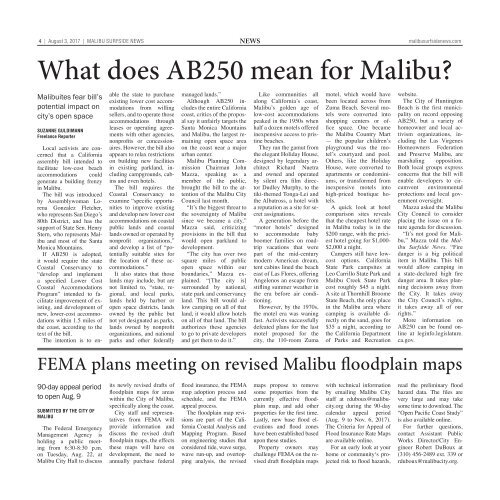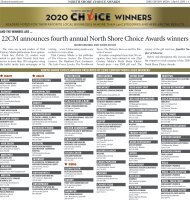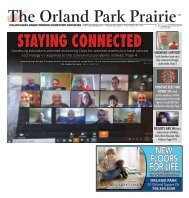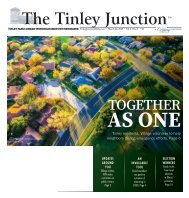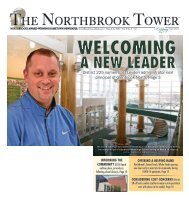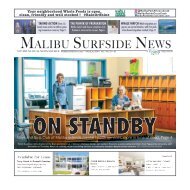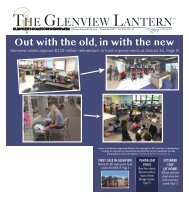MSN_080317
Malibu Surfside News 080317
Malibu Surfside News 080317
Create successful ePaper yourself
Turn your PDF publications into a flip-book with our unique Google optimized e-Paper software.
4 | August 3, 2017 | Malibu surfside news News<br />
malibusurfsidenews.com<br />
What does AB250 mean for Malibu?<br />
Malibuites fear bill’s<br />
potential impact on<br />
city’s open space<br />
Suzanne Guldimann<br />
Freelance Reporter<br />
Local activists are concerned<br />
that a California<br />
assembly bill intended to<br />
facilitate low-cost beach<br />
accommodations could<br />
generate a building frenzy<br />
in Malibu.<br />
The bill was introduced<br />
by Assemblywoman Lorena<br />
Gonzalez Fletcher,<br />
who represents San Diego’s<br />
80th District, and has the<br />
support of State Sen. Henry<br />
Stern, who represents Malibu<br />
and most of the Santa<br />
Monica Mountains.<br />
If AB250 is adopted,<br />
it would require the state<br />
Coastal Conservancy to<br />
“develop and implement<br />
a specified Lower Cost<br />
Coastal Accommodations<br />
Program” intended to facilitate<br />
improvement of existing,<br />
and development of<br />
new, lower-cost accommodations<br />
within 1.5 miles of<br />
the coast, according to the<br />
text of the bill.<br />
The intention is to enable<br />
the state to purchase<br />
existing lower cost accommodations<br />
from willing<br />
sellers, and to operate those<br />
accommodations through<br />
leases or operating agreements<br />
with other agencies,<br />
nonprofits or concessionaires.<br />
However, the bill also<br />
appears to relax restrictions<br />
on building new facilities<br />
in existing parkland, including<br />
campgrounds, cabins<br />
and even hotels.<br />
The bill requires the<br />
Coastal Conservancy to<br />
examine “specific opportunities<br />
to improve existing<br />
and develop new lower cost<br />
accommodations on coastal<br />
public lands and coastal<br />
lands owned or operated by<br />
nonprofit organizations,”<br />
and develop a list of “potentially<br />
suitable sites for<br />
the location of these accommodations.”<br />
It also states that those<br />
lands may include, but are<br />
not limited to, “state, regional,<br />
and local parks,<br />
lands held by harbor or<br />
open space districts, lands<br />
owned by the public but<br />
not yet designated as parks,<br />
lands owned by nonprofit<br />
organizations, and national<br />
parks and other federally<br />
managed lands.”<br />
Although AB250 includes<br />
the entire California<br />
coast, critics of the proposal<br />
say it unfairly targets the<br />
Santa Monica Mountains<br />
and Malibu, the largest remaining<br />
open space area<br />
on the coast near a major<br />
urban center.<br />
Malibu Planning Commission<br />
Chairman John<br />
Mazza, speaking as a<br />
member of the public,<br />
brought the bill to the attention<br />
of the Malibu City<br />
Council last month.<br />
“It’s the biggest threat to<br />
the sovereignty of Malibu<br />
since we became a city,”<br />
Mazza said, criticizing<br />
provisions in the bill that<br />
would open parkland to<br />
development.<br />
“The city has over two<br />
square miles of public<br />
open space within our<br />
boundaries,” Mazza explained.<br />
“[The city is]<br />
surrounded by national,<br />
state park and conservancy<br />
land. This bill would allow<br />
camping on all of that<br />
land, it would allow hotels<br />
on all of that land. The bill<br />
authorizes these agencies<br />
to go to private developers<br />
and get them to do it.”<br />
Like communities all<br />
along California’s coast,<br />
Malibu’s golden age of<br />
low-cost accommodations<br />
peaked in the 1950s when<br />
half a dozen motels offered<br />
inexpensive access to pristine<br />
beaches.<br />
They ran the gamut from<br />
the elegant Holiday House,<br />
designed by legendary architect<br />
Richard Nuetra<br />
and owned and operated<br />
by silent era film director<br />
Dudley Murphy, to the<br />
tiki-themed Tonga-Lei and<br />
the Albatross, a hotel with<br />
a reputation as a site for secret<br />
assignations.<br />
A generation before the<br />
“motor hotels” designed<br />
to accommodate baby<br />
boomer families on roadtrip<br />
vacations that were<br />
part of the mid-century<br />
modern American dream,<br />
tent cabins lined the beach<br />
east of Las Flores, offering<br />
Angelenos an escape from<br />
stifling summer weather in<br />
the era before air conditioning.<br />
However, by the 1970s,<br />
the motel era was waning<br />
fast. Activists successfully<br />
defeated plans for the last<br />
motel proposed for the<br />
city, the 110-room Zuma<br />
motel, which would have<br />
been located across from<br />
Zuma Beach. Several motels<br />
were converted into<br />
shopping centers or office<br />
space. One became<br />
the Malibu Country Mart<br />
— the popular children’s<br />
playground was the motel’s<br />
courtyard and pool.<br />
Others, like the Holiday<br />
House, were converted to<br />
apartments or condominiums,<br />
or transformed from<br />
inexpensive motels into<br />
high-priced boutique hotels.<br />
A quick look at hotel<br />
comparison sites reveals<br />
that the cheapest hotel rate<br />
in Malibu today is in the<br />
$200 range, with the priciest<br />
hotel going for $1,000-<br />
$2,000 a night.<br />
Campers still have lowcost<br />
options. California<br />
State Park campsites at<br />
Leo Carrillo State Park and<br />
Malibu Creek State Park<br />
cost roughly $45 a night.<br />
A site at Thornhill Broome<br />
State Beach, the only place<br />
in the Malibu area where<br />
camping is available directly<br />
on the sand, goes for<br />
$35 a night, according to<br />
the California Department<br />
of Parks and Recreation<br />
website.<br />
The City of Huntington<br />
Beach is the first municipality<br />
on record opposing<br />
AB250, but a variety of<br />
homeowner and local activism<br />
organizations, including<br />
the Las Virgenes<br />
Homeowners Federation<br />
and Preserve Malibu, are<br />
marshaling opposition.<br />
Both local groups express<br />
concerns that the bill will<br />
enable developers to circumvent<br />
environmental<br />
protections and local government<br />
oversight.<br />
Mazza asked the Malibu<br />
City Council to consider<br />
placing the issue on a future<br />
agenda for discussion.<br />
“It’s not good for Malibu,”<br />
Mazza told the Malibu<br />
Surfside News. “Fire<br />
danger is a big political<br />
item in Malibu. This bill<br />
would allow camping in<br />
a state-declared high fire<br />
danger area. It takes planning<br />
decisions away from<br />
the City. It takes away<br />
the City Council’s rights,<br />
it takes away all of our<br />
rights.”<br />
More information on<br />
AB250 can be found online<br />
at leginfo.legislature.<br />
ca.gov.<br />
FEMA plans meeting on revised Malibu floodplain maps<br />
90-day appeal period<br />
to open Aug. 9<br />
Submitted by the City of<br />
Malibu<br />
The Federal Emergency<br />
Management Agency is<br />
holding a public meeting<br />
from 6:30-8:30 p.m.<br />
on Tuesday, Aug. 22, at<br />
Malibu City Hall to discuss<br />
its newly revised drafts of<br />
floodplain maps for areas<br />
within the City of Malibu,<br />
specifically along the coast.<br />
City staff and representatives<br />
from FEMA will<br />
provide information and<br />
discuss the revised draft<br />
floodplain maps, the effects<br />
these maps will have on<br />
development, the need to<br />
annually purchase federal<br />
flood insurance, the FEMA<br />
map adoption process and<br />
schedule, and the FEMA<br />
appeal process.<br />
The floodplain map revisions<br />
are part of the California<br />
Coastal Analysis and<br />
Mapping Program. Based<br />
on engineering studies that<br />
considered tide, wave surge,<br />
wave run-up, and overtopping<br />
analysis, the revised<br />
maps propose to remove<br />
some properties from the<br />
currently effective floodplain<br />
map, and add other<br />
properties for the first time.<br />
Lastly, new base flood elevations<br />
and flood zones<br />
have been established based<br />
upon these studies.<br />
Property owners may<br />
challenge FEMA on the revised<br />
draft floodplain maps<br />
with technical information<br />
by emailing Malibu City<br />
staff at rduboux@malibucity.org<br />
during the 90-day<br />
calendar appeal period<br />
(Aug. 9 to Nov. 6, 2017).<br />
The Criteria for Appeal of<br />
Flood Insurance Rate Maps<br />
are available online.<br />
For an early look at your<br />
home or community‘s projected<br />
risk to flood hazards,<br />
read the preliminary flood<br />
hazard data. The files are<br />
very large and may take<br />
some time to download. The<br />
“Open Pacific Coast Study”<br />
is also available online.<br />
For further questions,<br />
contact Assistant Public<br />
Works Director/City Engineer<br />
Robert DuBoux at<br />
(310) 456-2489 ext. 339 or<br />
rduboux@malibucity.org.


